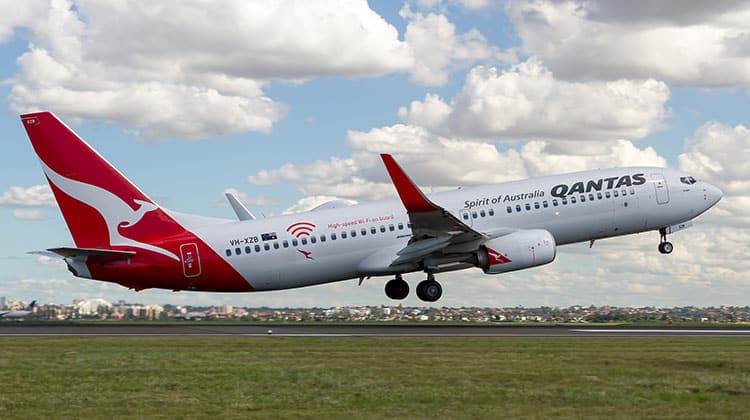Aviation
Australian regulator denies approval for Qantas-Japan Airlines deal

Qantas and Japan Airlines (JAL) have expressed their disappointment at the Australian Competition and Consumer Commission’s (ACCC) decision to block the airlines’ plans to form a joint business that would have boosted the recovery of tourism when international borders reopen.
The airlines had sought approval from the ACCC in December 2020 to work more closely together to better serve customers travelling between Australia, New Zealand and Japan and ensure a faster and sustained recovery from COVID.
Indigo to start cargo business converted 2 passenger jets to a full freighter.
As part of the agreement the airlines had proposed:
An expanded codeshare relationship to up to 29 destinations and better flight schedules between Australia, New Zealand and Japan.
A new direct route Cairns – Tokyo operated by Qantas.
Coordination of pricing, schedules, sales and tourism marketing supporting growth in key tourism markets.
Enhanced frequent flyer benefits and more premium travel opportunities for Qantas and JAL customers.
Qantas and JAL will continue their existing codeshare and oneworld partnership, which do not provide the same benefits than would have been possible under a joint business. Qantas and JAL have been partners in Jetstar Japan, one of the largest domestic low cost carriers in Japan, since 2012.
Qantas Airways Airbus A380 returns to the skies
Japan is the world’s third largest economy and one of Australia’s largest trade and investment partners. In 2019 half a million of its residents visited Australia, meaning it is one of the most important tourism and corporate markets as the recovery begins.
The 20 Safest Airlines in the World 2021

Aviation
COMAC Unveils Plans for the C929 to Rival Airbus and Boeing

After the success of China’s first C919 aircraft, the country is setting its sights on developing a larger plane. COMAC (Commercial Aircraft Corporation of China) has officially confirmed plans to build a widebody aircraft, marking a significant step in its aircraft lineup.
Traditionally, Airbus and Boeing dominate the widebody aircraft market, with decades of expertise in developing planes and engines capable of carrying heavy payloads. China, which currently relies on imported engines, is now aiming to challenge these giants with its own widebody jet, the C929, designed to compete with the Airbus A350 and Boeing 777.
American Airlines Is Looking for Flight Attendants: Apply Now
The C929 will be China’s first independently developed long-range widebody aircraft. It adheres to international airworthiness standards and boasts independent intellectual property rights. The baseline version is designed to seat 280 passengers and offers a range of 12,000 kilometers, catering to global demand for both regional and international air travel.
Russia, which also needs reliable narrowbody and widebody aircraft, could become a key customer for the C929. Additionally, China plans to target the broader Asian market as it continues to expand its aviation capabilities.
Close Call at Heathrow: BA Flight Narrowly Escapes Drone Collision
China’s aviation progress includes the ARJ21 (now called C909), a regional jet with 100 seats for shorter routes, and the C919, a narrowbody jet with 180 seats designed to rival the Boeing 737 MAX and Airbus A320. Both models have found increasing demand in the domestic market.
At China’s largest air show in Zhuhai, COMAC announced that Air China will be the launch customer for the C929 widebody jet, though details about order size and delivery timelines were not disclosed.
Other major deals announced by COMAC include:
- Hainan Airlines: Firm orders for 60 C919 and 40 C909 regional jets.
- Colorful Guizhou Airlines: 30 C909 jets, with 20 firm orders and 10 provisional agreements.
The C929, renamed from the CR929 after Russia withdrew from the joint development project in 2023, is expected to carry 280–400 passengers with a range of 12,000 kilometers, competing directly with Boeing’s 787 Dreamliner.
According to COMAC’s deputy general manager, Tong Yu, the first fuselage section of the C929 is expected by September 2027, with prototype test flights anticipated soon after.
-

 Aviation2 months ago
Aviation2 months agoMicrosoft Flight Simulator Raises $3 Million to Bring Back the An-225 Mriya
-

 Airlines2 months ago
Airlines2 months agoQantas Engineers Stage Walkout Over Cost of Living Concerns
-

 Airlines2 months ago
Airlines2 months agoQatar Citizens Can Travel to the United States Without a Visa
-

 Aviation2 months ago
Aviation2 months agoQatar Airways bans these new Electronic Devices on plane
-

 Airlines2 months ago
Airlines2 months agoJapan Airlines Rolls Out Free Domestic Flights to International Passengers
-

 Defence2 months ago
Defence2 months agoWhich Country Has the Largest Fleet of Fighter Aircraft?
-

 Airport2 months ago
Airport2 months agoWestern Sydney Airport Welcomes Its First Plane After 6 Years of construction
-

 Aviation2 months ago
Aviation2 months agoDid you know ? Once Boeing 747 carried 1088 passenger in 1991








